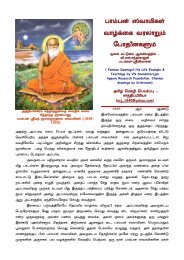Cult of the Child-God Crosses a Millennial Milestone
Cult of the Child-God Crosses a Millennial Milestone
Cult of the Child-God Crosses a Millennial Milestone
You also want an ePaper? Increase the reach of your titles
YUMPU automatically turns print PDFs into web optimized ePapers that Google loves.
<strong>Cult</strong> <strong>of</strong> <strong>the</strong> <strong>Child</strong>-<strong>God</strong> <strong>Crosses</strong> a <strong>Millennial</strong> <strong>Milestone</strong><br />
Skanda Kumara in <strong>the</strong> Mahabharata than to any o<strong>the</strong>r god. It appears from <strong>the</strong> Mahabharata XII.153.76 that<br />
Karttikeya was regarded as one <strong>of</strong> <strong>the</strong> four principal gods, namely Rudra, Kumara, Brahma and Visnu.<br />
The Ramayana has two chapters on Karttikeya's birth in <strong>the</strong><br />
Balakanda (chapters 36-37). The stories <strong>of</strong> Salya, Anusasana<br />
(86th chapter in Mahabharata) and Balakanda consistently<br />
make Karttikeya <strong>the</strong> son <strong>of</strong> all five deities: Siva, Agni, Ganga,<br />
Uma and <strong>the</strong> Krttikas. It appears that <strong>the</strong> authors <strong>of</strong> <strong>the</strong>se<br />
accounts were not sure about <strong>the</strong> parentage <strong>of</strong> Skanda and,<br />
<strong>the</strong>refore, thought it prudent to give <strong>the</strong> honour <strong>of</strong> parenthood<br />
to all five deities. In <strong>the</strong> later period <strong>the</strong> question <strong>of</strong> Skanda's<br />
parentage became almost an enigma, as shown by a sloka<br />
from <strong>the</strong> Adiparvan <strong>of</strong> <strong>the</strong> Mahabharata (cited in Asim Kumar<br />
Chatterjee, The <strong>Cult</strong> <strong>of</strong> Skanda-Karttikeya in Ancient India, p.<br />
13-14):<br />
Agneyah Krttikaputro Raudro Gangeya ityapi<br />
sruyate bhagavan devah sarvahuhyamayo Guhah<br />
"Some call him <strong>the</strong> <strong>of</strong>fspring <strong>of</strong> Agni, some <strong>of</strong><br />
<strong>the</strong> Krttikas, some <strong>of</strong> Rudra and some <strong>of</strong> Ganga.<br />
The illustrious Guha who combines in his<br />
composition <strong>the</strong> portions <strong>of</strong> o<strong>the</strong>r deities is <strong>of</strong> a<br />
lineage unknown."<br />
In both<br />
<strong>the</strong> epics and <strong>the</strong> Puranas, Karttikeya is repeatedly compared<br />
with <strong>the</strong> Sun god. In <strong>the</strong> Vanaparvan (chapt 224) we are told<br />
that <strong>the</strong> child Karttikeya 'shines like <strong>the</strong> sun rising in <strong>the</strong> midst<br />
<strong>of</strong> red clouds'. This association <strong>of</strong> god Skanda with <strong>the</strong> sun, <strong>the</strong><br />
dawn, and red clouds has obvious affinities to <strong>the</strong> ancient<br />
Dravidian god Ceyon, <strong>the</strong> Red <strong>God</strong> who is none o<strong>the</strong>r than<br />
Murukan. Indeed, <strong>the</strong> imagery <strong>of</strong> Skanda and Murukan<br />
continue to play a role in <strong>the</strong> popular imagination <strong>of</strong> Tamil<br />
people right down to <strong>the</strong> present day.<br />
Ancient Indians <strong>of</strong> both North and South noticed <strong>the</strong><br />
similarities from <strong>the</strong> very beginning and readily identified<br />
Skanda with Murukan. Over <strong>the</strong> centuries, pandits and<br />
devotees have spoken with one voice in agreeing that <strong>the</strong>se two<br />
are one and <strong>the</strong> same god. Never<strong>the</strong>less, <strong>the</strong>re are real<br />
difference between North and South, Skanda and Murukan,<br />
Tevayanai and Valli Amma. These differences are inescapable<br />
and undeniable. And yet, <strong>the</strong>y do not detract from <strong>the</strong> god's<br />
undying popularity and mystery. Ra<strong>the</strong>r, <strong>the</strong>y add dimensions<br />
<strong>of</strong> complexity that are <strong>of</strong>ten lacking in simpler deities.<br />
Murukan is a god <strong>of</strong> romantic love. He is <strong>the</strong> husband <strong>of</strong> not one wife but two. And yet, in <strong>the</strong> Nor<strong>the</strong>rn recension<br />
Karttikeya is an austere bachelor god.<br />
http://murugan.org/research/child_god.htm (2 <strong>of</strong> 4) [2/21/2002 10:05:01 PM]


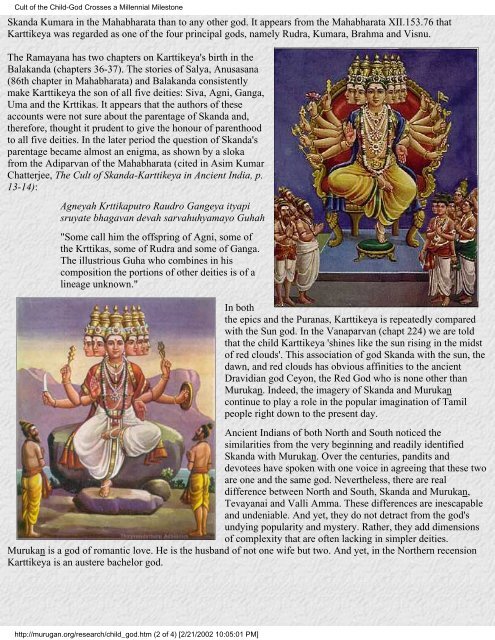
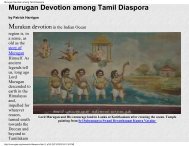
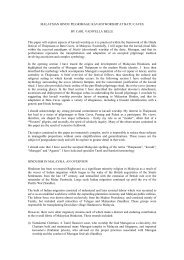
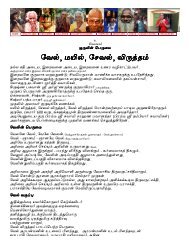
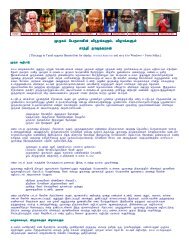
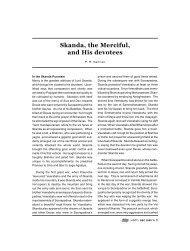
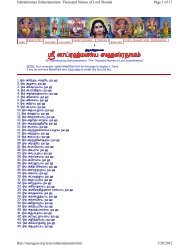
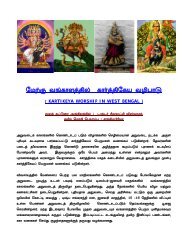
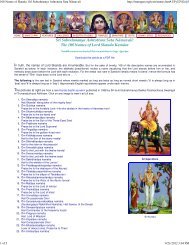
![gHdp k]y Myaj;jpw;F ghj ahj;jpiu fpuhkpa gHf;f Kiwfs;](https://img.yumpu.com/10245948/1/184x260/ghdp-ky-myajjpwf-ghj-ahjjpiu-fpuhkpa-ghff-kiwfs.jpg?quality=85)

